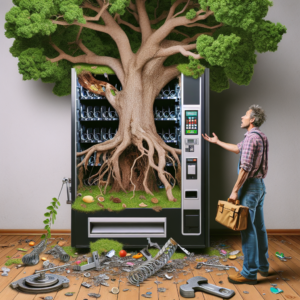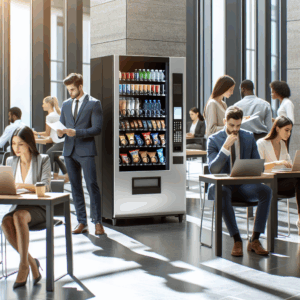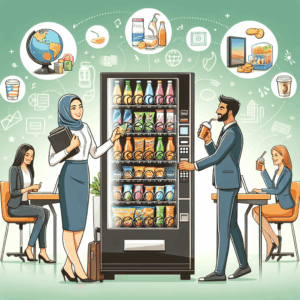Vending Machine Sensor Calibration
Understanding the Importance of Calibration
You might not initially think a vending machine needs precise calibration, but it really does. Sensors are the eyes and ears of the machine, making sure everything from snack dispensing to payment processing goes smoothly. If they’re off, your customers might get overcharged or won’t receive their selected snack. This can lead to unhappy customers and lost sales.
Calibration affects the machine’s accuracy in detecting what products are available and its ability to make accurate transactions. Imagine a scenario where a machine regularly spits out the wrong change. Without calibration, it’s chaos. By keeping sensors in check, we ensure everything operates like clockwork.
Now, don’t fret—calibrating these sensors isn’t rocket science. It’s about setting the right parameters and occasionally doing a little troubleshooting. I swear, once you get the hang of it, it becomes second nature.
Tools and Techniques for Calibration
Let’s get down to the nitty-gritty of calibration tools. A simple toolkit with screwdrivers, calibration weights, and some basic electronic tools are your new best friends. You don’t have to go all out like you’re assembling an IKEA furniture.
The process generally involves a few straightforward steps: identifying the sensor types and using relevant tools to fine-tune them. If it’s a weight sensor, you’ll need to use calibration weights to adjust it. For optical sensors, you might need to clean them to ensure they’re free of dust or smudges.
Calibration also involves a series of diagnostic checks to ensure everything is set accurately. This is where my patience gets tested, but a few attempts are usually all it takes to get it right.
Scheduling Regular Calibration
Regular maintenance schedules are a life-saver. Keeping a calendar when each machine needs a little TLC goes a long way. I usually set a bi-monthly schedule that’s easy enough to stick to.
Consistency is key here. Just as your car needs a regular oil change, vending machines need regular calibration. Missing these schedules can increase breakdowns, leading to more hassle and expense in the long run.
Trust me, when you care for your machines, they repay you with fewer troubleshooting calls and happier customers. Setting up a reminder on your phone or a calendar entry to check and calibrate sensors can keep you ahead of potential problems.
Cleaning and Sanitation Routines
Establishing a Sanitation Standard
When it comes to vending machines, cleanliness matters more than you might think. It’s the difference between a machine that customers trust and a machine that repels them. Establishing a strict cleaning routine is essential, and trust me, it’s more than just wiping down surfaces.
Every surface that customers might touch is a potential hotspot for germs. Ensuring that these areas are regularly sanitized keeps your customers safe and your machines welcoming. I remember a mentor once told me, “Make your machines so clean you wouldn’t mind eating off them.” A bit extreme, but you get the point.
Developing a checklist for sanitation helps keep everything in line. You cover all bases from the coin slot to the delivery tray. Not only does this keep the machine hygiene in check, but also maintains a professional appearance.
Essential Cleaning Supplies
Let’s talk supplies. Your cleaning kit should include things like disinfectant wipes, glass cleaner, and non-abrasive cloths. A lot of folks overlook the importance of non-abrasive materials—the last thing you want is scratched-up Plexiglas.
I once tried a new brand of cleaner that was supposedly top-notch, but it left smudges on the machine’s display. Learn from my mistake: Always stick to dependable supplies. Having the right cleaning tools makes the process efficient and effective.
Might sound odd, but there’s a sense of satisfaction in watching a spotless machine at work. Clean machines attract customers like bees to honey. Shiny, hygiene-secured machines mean more people willing to buy without a second thought.
Routine versus Deep Cleaning
There’s routine cleaning, and then there’s deep cleaning. Routine cleaning is a quick wipe down daily, ensuring all visible surfaces are sparkling. It’s akin to making your bed every morning—simple yet effective.
Deep cleaning, on the other hand, is when you put on your figurative overalls. This involves sanitizing every nook and cranny, even those parts customers will never see but affect machine function. Doing this monthly keeps the machine in top condition and extends its lifespan.
I usually book a whole afternoon once a month to perform deep cleans. It’s work-intensive, sure, but the reduction in machine malfunctions is worth the effort. Plus, my customers always comment on how tidy and well-maintained the machines are!
Inventory Management Techniques
Efficient Stock Monitoring
Vending machine inventory isn’t just about having candy bars to fill slots; it’s a real balancing act. Effective stock monitoring prevents shortages and overstock, both of which can be costly. By keeping an eye on what’s in demand, you cater better to customer preferences.
Back in the day, I used a simple spreadsheet. While it got the job done, it was time-consuming. These days, software tools that automatically track inventory levels and send alerts are a game-changer. They reduce manual errors and make re-stocking a breeze.
With an organized inventory system, you’re also less likely to find products past their sell-by dates hanging around your machines. Talk about a win-win for both customers and your bottom line!
Demand Forecasting
Demand forecasting is like peering into a crystal ball. Prediction tools analyze sales data and help forecast what the future demand might be. This insight is invaluable in ensuring your machines are stocked with what’s most likely to sell.
For instance, stocking up on cold beverages in summer can boost sales when everyone’s thirsting for a refreshing drink. Conversely, focusing on hot beverages in the winter has worked wonders for me. It’s all about adjusting to the rhythm of consumer demand.
Over the years, I’ve learned to trust these forecasting reports. They’re not perfect, but they provide a solid foundation for inventory decisions. The less guesswork involved, the more profits you can scoop up!
Addressing Theft and Shrinkage
Like it or not, theft happens, even with vending machines. Whether it’s a strategic tilt to trigger free falls or more tech-savvy approaches, combating shrinkage is crucial. Installing security features like cameras or anti-theft devices can deter would-be thieves.
I’ve had my fair share of frustrating theft incidents, and it’s definitely a motivation killer. However, modern machines come equipped with detection sensors that alert you to irregular activities. These have been a game-changer in maintaining inventory levels.
Additionally, regular audits help identify discrepancies. Knowing your stock levels and costs means any theft or shrinkage stands out and can be promptly addressed. It’s all about staying one step ahead.
Machine Software Updates
Why Updates Matter
Software updates might sound like IT lingo, but even vending machines need them to stay efficient. Just like your smartphone benefits from the latest updates, so does your vending machine. They enhance machine performance, ensuring everything runs smoothly.
In the past, I’d brush off updates thinking they were optional. Big mistake. Skipping updates can lead to slowdowns or security risks. Staying updated means peace of mind that your machine isn’t susceptible to glitches.
Software updates often come with features that improve user experience and operational capabilities. Trust me, keeping your software up-to-date makes a noticeable difference in how efficiently your machines operate.
How to Update Software
Updating your vending machine’s software isn’t as daunting as it sounds. Most manufacturers provide easy step-by-step guides for this. Start by checking the current software version, then download the latest firmware from the manufacturer’s site.
I’ve had moments fumbling through the process, but a bit of patience goes a long way. A simple USB stick can usually handle the transfer. Don’t panic if it takes a minute or two; it’s better to do it properly than rush through.
Sometimes, it’s worth having a technical support number handy. While I usually enjoy figuring things out myself, knowing I can call for backup is reassuring. Plus, once you’ve done it a couple of times, you’ll be a pro.
Scheduled Software Maintenance
Setting a fixed schedule for software checks is as important as calibrating sensors or cleaning the machine. Just like humans need regular health check-ups, your vending machines need periodic reviews to keep everything working efficiently.
Auto-scheduling updates or reminders ensures you don’t forget. Let’s be honest, with everything involved in running a vending machine business, an automatic nudge can be golden. I’d set quarterly reminders to check for updates and schedule this alongside other routine maintenance tasks.
Being proactive with software maintenance prevents many headaches. I’ve found this habit has saved me from unexpected downtimes, allowing me to focus on bigger business strategies instead.
FAQ
1. How often should vending machines be calibrated?
It’s generally a good idea to schedule calibration for vending machines every two months. Consistent calibration ensures that the sensors and dispensing mechanisms function correctly, minimizing operational hiccups and maximizing customer satisfaction.
2. What cleaning supplies are safe for vending machines?
Always use non-abrasive cloths and mild solutions such as disinfectant wipes and glass cleaner. Harsh chemicals and abrasive materials can damage machine components and surfaces, leading to unnecessary wear and tear.
3. How can I reduce theft from my vending machines?
Install security measures such as cameras and anti-theft devices. Regular auditing and maintaining precise inventory records will also help identify and address any instances of shrinkage promptly.
4. Why are software updates important in vending machines?
Software updates ensure that vending machines run efficiently and securely. They fix bugs, enhance features, and can even provide new functionalities, leading to better performance and user experience.



